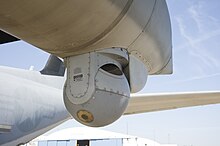Lockheed Martin KC-130
The Lockheed Martin KC-130 is the basic designation for a family of the extended-range tanker version of the C-130 Hercules transport aircraft modified for aerial refueling. The KC-130J is the latest variant operated by the United States Marine Corps, with 38 delivered out of 47 ordered. It replaced older KC-130F and KC-130R variants, while USMC reserve units still operate 28 KC-130T aircraft.
Harvest HAWK


With the addition of the Marine Corps's ISR / Weapon Mission Kit, the KC-130J will be able to serve as an overwatch aircraft and can deliver ground support fire in the form of Hellfire or Griffin missiles, precision-guided bombs, and eventually 30mm cannon fire in a later upgrade. This capability, designated as "Harvest HAWK" (Hercules Airborne Weapons Kit), can be used in scenarios where precision is not a requisite, such as area denial.
The AN/AAQ-30 Targeting Sight System (TSS) integrates an infrared and television camera, and is mounted under the left wing's external fuel tank. It is the same TSS used on the upgraded AH-1Z Viper attack helicopter . The typical loadout is four Hellfire missiles and 10 Griffin GPS guided missiles. The weapons systems operator uses a Fire Control Console mounted on a standard cargo pallet in the KC-130J’s cargo compartment.
The aircraft retains its original capabilities in refueling and transportation. The entire system can be removed in less than a day if necessary. The USAF MC-130W Dragon Spear program uses a similar concept.
The USMC plans to acquire three kits per active-duty KC-130J squadron for a total of nine kits, each costing up to US$22 million. It was first test flown on 29 August 2009 by VX-20, and first deployed in October 2010 with VMGR-352.
Specifications (KC-130J)

Data from Lockheed Martin KC-130J Super Tanker fact sheet
General characteristics
- Crew: 4 (two pilots,one crew chief and one loadmaster are minimum crew)
- Capacity: :* 92 passengers or
-
- 64 airborne troops or
- 6 pallets or
- 74 litter patients with 2 medical personnel
- 2–3 Humvees or an M113 armored personnel carrier
- Payload: 42,000 lb (19,090 kg)
- Length: 97 ft 9 in, 29.79 m (for C-130J-30: 112 ft, 9 in, 34.69 m)
- Wingspan: 132 ft 7 in (40.41 m)
- Height: 38 ft 10 in (11.84 m)
- Wing area: 1,745 ft² (162.1 m²)
- Empty weight: 75,562 lb (34,274 kg)
- Useful load: 72,000 lb (33,000 kg)
- Max. takeoff weight: up to 175,000 lb (79,378 kg); normal 155,000 lb (70,305 kg)
- Powerplant: 4 × Rolls-Royce AE 2100D3 turboprop, 4,637 shp (3,458 kW) each
- Propellers: Dowty R391 6-blade composite propeller, 1 per engine
Performance
- Maximum speed: 362 knots (417 mph, 671 km/h)
- Cruise speed: 348 kn (400 mph, 643 km/h)
- Range: 2,835 nmi (3,262 mi, 5,250 km)
- Service ceiling: 28,000 ft (8,615 m) with 42,000 pounds (19,090 kilograms) payload
- Takeoff distance: 3,127 ft (953 m) at 155,000 lb (70,300 kg) gross weight
The information contained on this page is unclassified, approved for public dissemination and is released under CC-BY-SA Licensing Agreement.

